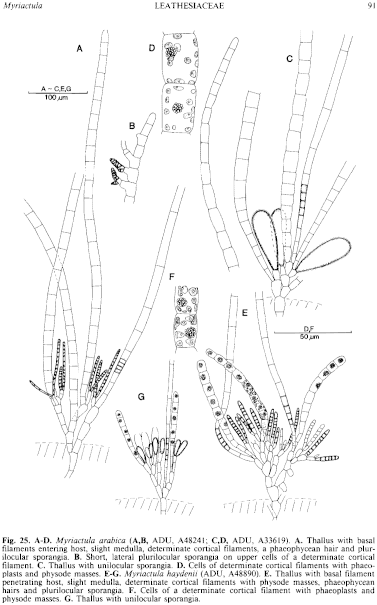|
|
|
|
|
|||||||||||
|
Electronic Flora of South Australia Species Fact Sheet
Phylum Phaeophyta – Order Chordariales – Family Leathesiaceae
Selected citations: Ardré 1970: 252, p1. 38 figs 2,3, pl. 58 fig. 1.
Synonyms
Phycophila arabica Kützing 1858: 1, pl. 1 fig. II.
Gonodia arabica (Kützing) Boergesen 1934: 22, fig. 4. Hamel 1935: 136, fig. 31,3.
Myriactis arabica (Kützing) Kuckuck 1929: 38, figs 37–39.
Thallus (Fig. 25A,C) forming minute tufts on Sargassum leaves or Hydroclathrus, 0.5–1 mm high, with the basal part endophytic, a relatively slight medulla bearing a stratum of sporangia, and long, free cortical filaments and hairs. Basal filaments (Fig. 25A) in a small group, penetrating the host meristoderm. Medulla (Fig. 25A,C) of compact, branched filaments 40–100 µm and 3–5 cells long, cells 10–24 µm in diameter and L/B mostly 1.5–3. Determinate cortical filaments (Fig. 25A,C) straight to slightly curved, 400–900 µm and 10–30 cells long, tapering slightly in their upper half, with apical and intercalary divisions, cells almost cylindrical, 16–20 (–22) µm in greatest diameter and L/B (1–) 1.5–2 (–2.5). Phaeoplasts (Fig. 25D) several per cell, discoid, each with a pyrenoid; physodes usually as a central, clustered mass. Phaeophycean hairs frequent, produced from upper medullary cells, 8–15 µ in diameter.
Reproduction: Plurilocular sporangia (Fig. 25A) produced from upper medullary cells and forming a stratum at base of cortical filaments, uniseriate, 50–80 µm and 14–20 locules long, 5–7 µm in diameter; short plurilocular sporangia (Fig. 25B) also formed on upper parts of determinate cortical filaments, 20–30 Aim and 6–8 locules long, 8–10 µm in diameter. Unilocular sporangia (Fig. 25C) produced on upper medullary cells, clavate, 50–90 µm long and 16–30 µm in diameter.
Type from the Arabian Gulf, on Cystoseira myrica; in L (?)
Distribution: Arabian Sea, Tanzania, Red Sea, Mediterranean and Western Europe, on various Fucales.
In southern Australia known from off Troubridge Light, S. Aust., on Sargassum distichum, 10 m deep (Shepherd, 4.ii.1969; ADU A33619, with unilocular sporangia). Lady Bay, Normanville, S. Aust., on Sargassum in lower eulittoral pool (Skinner, 14.ix.1977; ADU, A48241, with plurilocular sporangia) and on Hydroclathrus, drift (Skinner, 10.xi.1977; ADU, A48827).
Taxonomic notes: The above three collections agree well in habit and dimensions with the illustrations of Kützing, Boergesen and Ardré of Myriactula arabica, but checking of further collections is desirable.
References:
ARDRÉ, F. (1970). Contribution a l'etude des algues marines du Portugal I-La flore. Port. Acta Biol., ser. B., 10, 1–423, Plates 1–56.
BOERGESEN, F. (1934). Some marine algae from the northern part of the Arabian Sea with remarks on their geographical distribution. K. Dan. Vidensk. Selsk. Biol. Meddr 11(6), 1–72, Plates I, 2.
FELDMANN, J. (1937). Les Algues marines de la Côte des Albères. I–III. Cyanophycées, Chlorophycées, Phéophycées. Rev. Algol. 9, 141–335, Plates 8–17.
FELDMANN, J. (1943). Une nouvelle espèce de Myriactula parasite du Gracilaria armata J. Ag. Bull. Soc. Hist. Nat. Afr. Nord 34, 222–229.
HAMEL, G. (1935). Phéophycées de France. Fasc. II, pp. 81–176. (Paris.)
KÜTZING, F.T. (1858). Tabulae Phycologicae. Vol. 8. (Nordhausen.)
KUCKUCK, P. (1929). Fragmente einer Monographie des Pheosporeen. Biol. Anst. Helgol. 17, 1–93.
The Marine Benthic Flora of Southern Australia Part II complete list of references.
Publication:
Womersley, H.B.S. (14 December, 1987)
The Marine Benthic Flora of Southern Australia
Part II
©Board of the Botanic Gardens and State Herbarium, Government of South Australia
Illustration in Womersley Part II, 1997: FIG. 25 A–D.

Figure 25 enlarge
Fig. 25. A–D. Myriactula arabica (A,B, ADU, A48241; C,D, ADU, A33619). A. Thallus with basal filaments entering host, slight medulla, determinate cortical filaments, a phaeophycean hair and plurilocular sporangia. B. Short, lateral plurilocular sporangia on upper cells of a determinate cortical filament. C. Thallus with unilocular sporangia. D. Cells of determinate cortical filaments with phaeoplasts and physode masses. E–G. Myriactula haydenii (ADU, A48890). E. Thallus with basal filament penetrating host, slight medulla, determinate cortical filaments with physode masses, phaeophycean hairs and plurilocular sporangia. F. Cells of a determinate cortical filament with phaeoplasts and physode masses. G. Thallus with unilocular sporangia.

|
Email Contact: State Herbarium of South Australia |

|